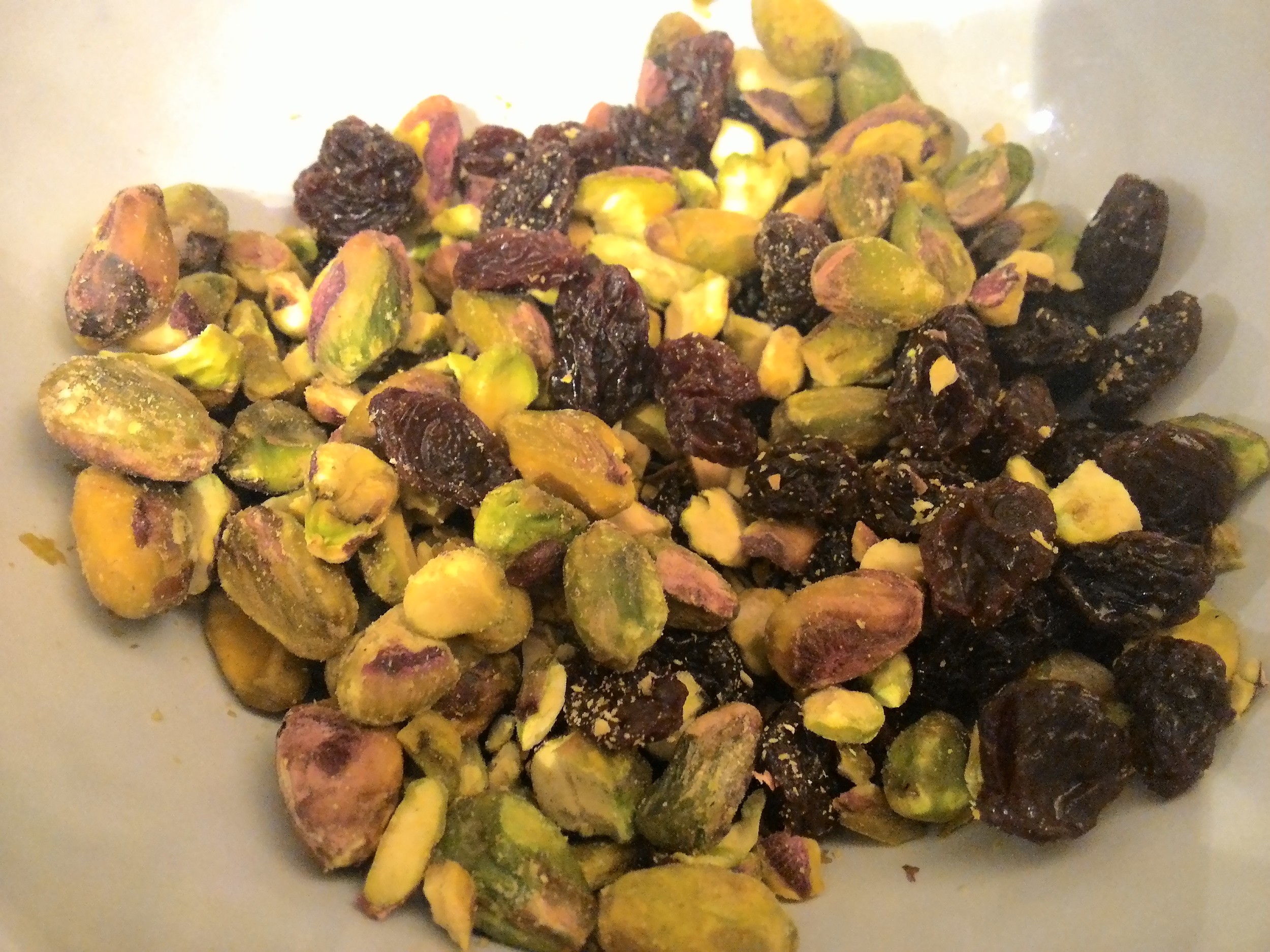Lunch in Damascus
Mutabal Shawandar
I didn't have time this weekend to make anything complicated, but in truth even if I did have the extra hours, the excessively hot temperatures had me craving simple, cold foods. Although at some point, I must try my hand at basic hummus, I was drawn to this recipe for its potential to yield a healthful cool dip robust in flavor as well as color.
EXTREME BEET GARLIC CLOSE-UP
Syrian Cooking's ingredient list (garlic, canned or fresh beets, tahini, olive oil) is straight-forward as are the directions. I would add only that if you used canned beets, especially beet strings, the boiling process is not necessary.
What is imperative is ample olive oil for creaminess and quality tahini, which provides wonderful nutty notes that balance the sweet botanical flavor of the beets and the tangy garlic.
I am not ashamed to say I ate much of my product with a spoon; however, pita toasts are probably more dignified.
Hashweh. The glow reflects the deliciousness.
I know, I know, it's been fo'evah since I last posted. Although Bridey has been very busy at work and with writing projects, that is no excuse. I began 2016 on a mission to explore the world of Syrian cuisine and I have barely made a dent in my itinerary. So, this summer I am recommitting myself to eating, cooking, and researching Syrian food, with a special focus on Damascene dining. To that end, last night I attempted to make Hashweh, also known as 'rice stuffing.' Multiple Middle Eastern countries offer different renditions of this dish, but there are certain components (ground lamb, medium- to long-grain rice, nuts, dried fruit, cinnamon, onion) common to most versions.
Nothing that involves pistachios or raisins could be bad.
A while back Aussie Beef & Lamb gifted me with some generous cuts, which I used for an auspicious family gathering. The last part of their present was a package of ground lamb, which the lazy cook in me was tempted just to use to make burgers with feta and mint sauce. However, ambitious Bridey took over and decided to make Hashweh. The recipe below is modified from that developed by Suzy at The Mediterranean Dish. I used white onions instead of red and pistachios instead of almonds because for whatever reason I couldn't find slivered almonds (time crunch, couldn't handle advanced knife skills) at Randalls. I blame their absence on Trump, because, well, these days I blame everything on Trump. Moving on.
INGREDIENTS
- 1½ cups medium grain rice
- Olive oil
- 1 small white onion, finely chopped
- 1 lb ground lamb
- 1¾ tsp allspice, divided
- 1 tsp garlic powder
- ¾ tsp ground cloves, divided
- ¾ tsp ground cinnamon, divided
- salt and pepper
- ½ cup fresh parsley leaves, roughly chopped
- ⅓-1/2 cup pine nuts, toasted
- ⅓-1/2 cup pistachios
- ½ cup dark raisins
INSTRUCTIONS
- Soak the rice in cold water for 20 minutes. Drain well.
- Heat 1 tbsp of olive oil in a heavy cooking pot. Add chopped onions in the oil on medium-high heat. Add the ground lamb and cook 7 minutes.
- Add seasonings: 1¼ tsp allspice, 1 tsp garlic powder, ½ tsp ground cloves, ½ tsp ground cinnamon, salt and pepper. Toss together to combine, and cook until the meat is fully browned (8-10 minutes).
- Drain from fat, leaving the meat in the same pot.
- Top the meat with the rice. Add the remainder of the allspice, ground cloves and cinnamon. Add 2½ cups of water to cover the rice.
- Bring the liquid to a rolling boil and allow liquid to reduce significantly.
- Turn the heat to low and cover. Cook for 15 minutes or until moisture has completely been absorbed. Remove from heat.
- Place a large serving platter on the opening of the rice pot and carefully flip the pot contents onto the platter so that the meat layer is on top of the rice.
- Garnish with parsley, toasted pine nuts, pistachios, and raisins.
Don't skimp on the spices.
I can't emphasize enough the importance of using high quality spices in the preparation of this dish; also, for those like me who enjoy the type of winter-y sweetness that comes from cinnamon, add a whole stick.
Technically, Hashweh is a side dish, but technically so is macaroni and cheese, nothing prevents me from eating that as my main course.
Polo
No, this post does not contain instructions on how to play golf while riding a horse. Sorry.
Polo, as I learned from the terrific blog, Syrian Foodie in London, is the name for a cool specialty beverage from Damascus, which, I can tell you from experience, can get very, VERY hot.
As you can see from the recipe below, the ingredients are fairly straight-forward and would likely be found on any given Friday in my kitchen, save one component: orange blossom water.
POLO
Ingredients:
4 cups water
Juice of 5 lemons
6 tablespoons sugar
1.5 cups fresh mint leaves, rinsed and drained
1 tsp. orange blossom water
But, lo and behold, I had picked up a bottle during my visit to Jerusalem Halal Market.
Directions:
Blend and strain.
Piquant, tart, and oh-so-refreshing.
YES!
A long, long time ago in a country not so far away, I had magnificent dessert at the pre-wedding cocktail party of a great friend. It was knafe, an impeccable square of soft goat's milk cheese, doused in syrup, and dusted with pistachios.
I'll take a dozen.
After MUCH searching, I have found my knafe fix in Houston! Go here for my account.
Partial ingredient display.
Second attempt at Syrian cuisine was again an exercise in simplicity (I hoped). I googled "Syrian tabouli" (change in spelling noted) and used the first recipe I found on syriancooking.com. It is one of the most comprehensive Syrian food blogs on the web with a diverse array of recipes for appetizers, mains, desserts, and side dishes.
Is it completely blasphemous that I used Spanish olive oil and paprika?
Unfortunately, halfway through the preparation I discovered the ingredient portions were incomplete, specifically the amount of paprika: "1/2 [WHAT??] paprika." So, I had to guesstimate based on other recipes' proportions.
The result was nevertheless delicious, though the texture a bit rough thanks to my rather frantic chopping skills, which gave rise to inconsistently sized vegetable chunks.
Tabouleh landscape.
To be refined at a later date...
Approximately 300 different types of flour.
High off a fabulous first visit to A Sweet Factory, I trudged an arduous 20 feet to Jerusalem Halal Market. I was greeted with tons of canned, fresh, and frozen Middle Easter products (pomegranate syrup! baba ganoush! samosa! maamoul!) plus tons of basic dry good ingredients.
I'll take 3 of each.
I picked some stuffed grape leaves, baba ganoush (is there really one official transliterated spelling?), and orange blossom water. I could have bought 1000 more things, but let's wait until I win the PowerBall.
Supermarket prayer room.
Erm, perhaps you say, I go to Phoenicia for such things. Well, that's all well and good, and I have nothing against Phoenicia, especially the Westheimer location
BUT JHM's prices are much lower and they have a prayer room. I observed many patrons stopping in to, I can only assume, mediate or perform salah. It was quaint, stunning, and endearing all at once.
Among the patrons chattering in Urdu and Arabic, many clothed in hijabs, I stood out in my arguably ridiculous weekend uniform of sweat pants and a Disney hoodie. Nevertheless, I assisted readily by a friendly clerk and the checkout employee even waived the credit card minimum.
I really like this place.
Ingredients assembled
In an effort to keep it simple as I can be quite stupid sometimes in the kitchen, I decided to make (Syrian) rice. I remember the rice in Damascus being soft and redolent of chicken broth and cumin. I found several recipes online, and curiously, all involved two ingredients I did not readily associated with Syrian/Middle Eastern cooking: 1) Butter 2) Pasta. Also, one of the recipes, actually the one I ended up using, was on a "Real Housemoms" website. (In the future, I hope to God Syria is back on track enough to host a "Real Housewives of Aleppo.")
Those elements that did strike as reminiscent of the region were pine nuts and cinnamon. For whatever reason, many Western cuisines have relegated the latter ingredient exclusively to the realm of desserts and in so doing fail to see its delicious potential when used in savory dishes.
Cooking down the broth
So, it wasn't great. I appreciated the textural variations provided by the inclusion of nuts as well as grains but the seasonings proportions were way off: too much cinnamon and not enough earthy or protein flavors. Keeping it simple, it seems, was the wrong strategy.
After our trip to Damascus, Wyatt bought a Syrian and Lebanese cookbook on which I will rely heavily in the coming months. It has several recipes for rice that look more promising.
Dining at Naranj
Today of all days Facebook reminded me that six years ago around this time I was in Damascus for the wedding of my dear friends Fahad and Lena. The food was plentiful and all of it delicious. Today, also, I encountered absolutely devastating images of Syrian children on the brink of starvation due to the embargo on food aid into the country during the war.
Part of my motivation for writing this blog on Syrian food right now is a pathetic attempt to combat my grief over the destruction of a country and people that are not are even my own but for whom I feel great affection. But I also want people to know and recognize the richness and value of Syria and its people by displaying just one dimension of its culture: the food.
Lunch at home of my friend in Damascus.
I am a mediocre cook at best. I will probably fail miserably 60% of the time in my attempts to replicate authentic Syrian cuisine. (If my husband, who has successfully mastered many Middle Eastern dishes, helps me that percentage may decrease to 30%.) Regardless, it will be an adventure. Comments and suggestions welcome.






















